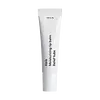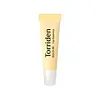What's inside
What's inside
 Key Ingredients
Key Ingredients

 Benefits
Benefits

 Concerns
Concerns

 Ingredients Side-by-side
Ingredients Side-by-side

Ricinus Communis Seed Oil
MaskingHydrogenated Castor Oil
EmollientPhytosteryl/Isostearyl/Cetyl/Stearyl/Behenyl Dimer Dilinoleate
Skin ConditioningCaprylic/Capric Triglyceride
MaskingBeeswax
Emulsion StabilisingCandida Bombicola/Glucose/Methyl Rapeseedate Ferment
AntimicrobialCopernicia Cerifera Wax
Oryza Sativa Germ Oil
EmollientLactobacillus Ferment Lysate
Skin ConditioningCitrus Aurantium Bergamia Fruit Oil
MaskingPelargonium Graveolens Flower Oil
MaskingSalvia Officinalis Oil
MaskingPogostemon Cablin Leaf Oil
MaskingArgania Spinosa Kernel Oil
EmollientCamellia Japonica Seed Oil
EmollientRosa Canina Fruit Oil
EmollientSimmondsia Chinensis Seed Oil
EmollientPolyethylene
AbrasivePanthenol
Skin ConditioningDehydroacetic Acid
PreservativeLimonene
PerfumingCitronellol
PerfumingLinalool
PerfumingGeraniol
PerfumingRicinus Communis Seed Oil, Hydrogenated Castor Oil, Phytosteryl/Isostearyl/Cetyl/Stearyl/Behenyl Dimer Dilinoleate, Caprylic/Capric Triglyceride, Beeswax, Candida Bombicola/Glucose/Methyl Rapeseedate Ferment, Copernicia Cerifera Wax, Oryza Sativa Germ Oil, Lactobacillus Ferment Lysate, Citrus Aurantium Bergamia Fruit Oil, Pelargonium Graveolens Flower Oil, Salvia Officinalis Oil, Pogostemon Cablin Leaf Oil, Argania Spinosa Kernel Oil, Camellia Japonica Seed Oil, Rosa Canina Fruit Oil, Simmondsia Chinensis Seed Oil, Polyethylene, Panthenol, Dehydroacetic Acid, Limonene, Citronellol, Linalool, Geraniol
Polyisobutene
Petrolatum
EmollientDiisostearyl Malate
EmollientSimmondsia Chinensis Seed Oil
EmollientButyrospermum Parkii Butter
Skin ConditioningSorbitan Sesquioleate
EmulsifyingMacadamia Ternifolia Seed Oil
EmollientOlea Europaea Fruit Oil
MaskingAdansonia Digitata Seed Oil
EmollientCeramide NP
Skin ConditioningCeramide Ns
Skin ConditioningCeramide As
Skin ConditioningCeramide EOP
Skin ConditioningCeramide AP
Skin ConditioningStearic Acid
CleansingCholesterol
EmollientVinegar
Sodium Hyaluronate
HumectantPanthenol
Skin ConditioningTrehalose
HumectantHydrogenated Lecithin
EmulsifyingMicrocrystalline Wax
Emulsion StabilisingSargassum Fusiforme Extract
Skin ProtectingGlycerin
HumectantButylene Glycol
HumectantWater
Skin ConditioningCaprylic/Capric Triglyceride
Masking1,2-Hexanediol
Skin ConditioningPolyisobutene, Petrolatum, Diisostearyl Malate, Simmondsia Chinensis Seed Oil, Butyrospermum Parkii Butter, Sorbitan Sesquioleate, Macadamia Ternifolia Seed Oil, Olea Europaea Fruit Oil, Adansonia Digitata Seed Oil, Ceramide NP, Ceramide Ns, Ceramide As, Ceramide EOP, Ceramide AP, Stearic Acid, Cholesterol, Vinegar, Sodium Hyaluronate, Panthenol, Trehalose, Hydrogenated Lecithin, Microcrystalline Wax, Sargassum Fusiforme Extract, Glycerin, Butylene Glycol, Water, Caprylic/Capric Triglyceride, 1,2-Hexanediol
 Reviews
Reviews

Ingredients Explained
These ingredients are found in both products.
Ingredients higher up in an ingredient list are typically present in a larger amount.
This ingredient is an emollient, solvent, and texture enhancer. It is considered a skin-softener by helping the skin prevent moisture loss.
It helps thicken a product's formula and makes it easier to spread by dissolving clumping compounds.
Caprylic Triglyceride is made by combining glycerin with coconut oil, forming a clear liquid.
While there is an assumption Caprylic Triglyceride can clog pores due to it being derived from coconut oil, there is no research supporting this.
Learn more about Caprylic/Capric TriglyceridePanthenol is a common ingredient that helps hydrate and soothe the skin. It is found naturally in our skin and hair.
There are two forms of panthenol: D and L.
D-panthenol is also known as dexpanthenol. Most cosmetics use dexpanthenol or a mixture of D and L-panthenol.
Panthenol is famous due to its ability to go deeper into the skin's layers. Using this ingredient has numerous pros (and no cons):
Like hyaluronic acid, panthenol is a humectant. Humectants are able to bind and hold large amounts of water to keep skin hydrated.
This ingredient works well for wound healing. It works by increasing tissue in the wound and helps close open wounds.
Once oxidized, panthenol converts to pantothenic acid. Panthothenic acid is found in all living cells.
This ingredient is also referred to as pro-vitamin B5.
Learn more about PanthenolThis oil comes from the seeds of the desert shrub called Jojoba. It is more commonly known as jojoba oil, a non-comedogenic oil.
Jojoba oil does not contain fragrance and has many fatty-acids, making it a great soothing ingredient.
It also contains Vitamin E, a great moisturizing ingredient. Vitamin E is also an antioxidant and protects your skin against oxidative damage.
This ingredient humectant properties, meaning it helps draw moisture from the air. This helps keep your skin hydrated.
While jojoba has antibacterial properties, it is only able to kill some strains of bacteria.
Studies also show it helps in wound healing. In fact, Indigenous cultures have used jojoba as a moisturizer and to help treat burns for centuries.
Fun fact: Jojoba oil similar to natural human skin sebum, so it has a great effect on dry skin. It is also promising with helping to regulate sebum production.
Due to its fatty acid content, Jojoba oil may not be fungal acne safe. We recommend speaking with a professional if you have any concerns.
Learn more about Simmondsia Chinensis Seed Oil